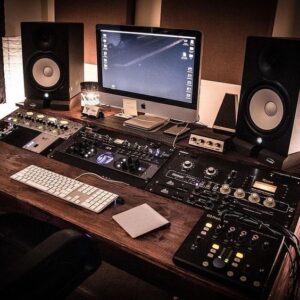
If you’re shopping for monitor isolation pads for your home studio…
But you aren’t quite sure what you’re looking for, or how to tell the difference between one and the next…you’ve come to the right place.
Because in this ultimate guide, we’ll look at the 6 best monitor isolation pads currently on the market to see just how they compare.
First up…
The Original Monitor Isolation Pads That Started it All
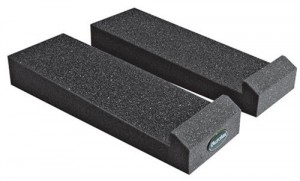
One of the first monitor isolation pads to gain widespread recognition…
The original Auralex MoPads paved the way for the many models we now have today.
With its beautifully simple design, it offers a cheap and effective way to improve monitor accuracy by reducing the low-end vibration transfer to the desk.
To adjust monitor tilt, an additional foam wedge insert can be added to create a slope of 4, 8, or 0 degrees.
To make it one-size-fits-all, a single pad consists of two narrow strips, which can be spread to align flush with the edges of the monitor.
All-in-all, it’s a beautiful accessory.
- Auralex MOPADs – (Amazon/Sweetwater/Thomann)
Up next…
An Upgraded Version of the Original Mopads
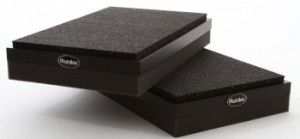
After the massive success of the MoPads, Auralex came back with version 2.0: the Auralex ProPAD.
On looks alone, the improvements to these monitor isolation pads are obvious.
In terms of performance, here’s what’s new:
- They added a Melamine-wrapped MDF base and their trademarked ISO-Plate on top to eliminate slippage and increase acoustic isolation.
- They moved the foam wedge to the bottom…meaning upward tilts are now possible, without needing to awkwardly reverse the pads, as you would with the MoPads.
They’re a bit more expensive than the originals, but users largely agree that it’s well worth the added cost.
- Auralex ProPADs – (Sweetwater/Thomann)
Up next…
Monitor Isolation Pads with a Unique Anti-Recoil Design
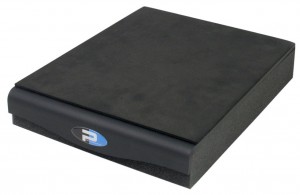
With a look and design very similar to the ProPADs, the Primacoustic RX7 offers the same advantages, with one big difference:
Its unique anti-recoil design combines 3 layers of separation:
- On the Bottom – a layer of high-density urethane foam for acoustic isolation
- On Top – a layer of neoprene for slip-resistance and added shock absorption
- In the Middle – a steel plate for added mass and stability
One useful feature lacking in these monitor isolation pads however, is the adjustable tilt. Instead, they offer several models of varying tilts and sizes.
The medium RX7 is ideal for typical monitors, but here’s a full list of the options:
- RX7 flat 10.5″ x 13″ – (Amazon/Sweetwater)
- RX7 angled 10.5″ x 13″ – (Amazon/Sweetwater)
- RX12 flat 20″ x 13″ – (Sweetwater)
- RX12 angled 20″ x 13″ – (Sweetwater)
- RX9 flat 15″ x 11″ – (Amazon/Sweetwater)
- RX9 angled 15″ x 11″ – (Amazon/Sweetwater)
Up next…
The Ultimate Solution in Monitor Isolation Pads
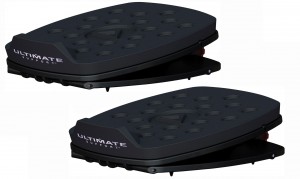
Of all the options on this list…the Ultimate Support MS-80 is by far my favorite.
Besides its sleek and sophisticated design, it has 2 useful features the others don’t:
- Precision Tilt Adjustment – rather than only offering 2 or 3 tilt options, a crank on the back lets you easily fine-tune the tilt angle to exactly as you wish.
- Decoupling spikes – beneath the metal base plate are 4 spikes designed to reduce sound transfer by minimizing direct contact with the desk. (Don’t worry, the spikes won’t damage anything.)
While they’re certainly NOT cheap, I do believe that currently, the MS-80’s are the best isolation pads money can buy, and well worth the cost.
Here’s the link:
- Ultimate Support MS-80 – (Amazon/Sweetwater)
Up next…
A Futuristic Design in Monitor Isolation

Easily the strangest pads on the list, the Isoacoustics ISO-L8R155 takes an entirely different approach to monitor isolation pads.
While you might think they look silly and possibly unstable…they’ve gotten TONS of RAVE reviews since their release.
Three things I like about them are:
- They offer almost as many tilt options as the MS-80
- They offer unmatched flexibility with height adjustment
- They have possibly the best shock absorption available, for optimal decoupling.
This second feature can be especially useful on larger desks, to lift your monitors up and away from potential reflection surfaces.
One possible drawback however, is that the setup is somewhat complicated, and adjusting the tilt requires you to swap out parts. But at worst, it’s a minor inconvenience on an otherwise stellar product.
The product comes in 4 sizes, medium being the standard that works best with most monitors. Here are the others as well:
- MEDIUM 6.1″ x 7.5″ – (Amazon/Sweetwater/Thomann)
- LARGE 7.8″ x 10″ – (Amazon/Sweetwater/Thomann)
- SMALL 5.1″ x 6″ – (Amazon/Sweetwater/Thomann)
- SUBWOOFER – (Amazon/Sweetwater/Thomann)
IsoAcoustic also offers a pretty neat tool to find the exact stand for your speakers. You can check it out here.
Now to wrap up the list…
The Most Ultra-Effective Decouplers Ever Created
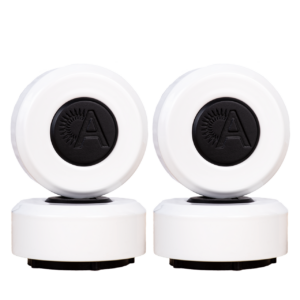
Despite already dominating the market in monitor isolation pads, and acoustic treatment in general…
Auralex continues to raise the bar, year after year, with ever-improving technologies.
One of the most recent and fascinating new products is the peculiar-looking Auralex ProPod.
With 4 separate feet per monitor, this new innovative design is said to be quite possibly the single most effective decoupler to date.
To see the ProPd’s in action in a real-life performance test, check out this video:
Here’s the link:
- Auralex ProPod – (Amazon/Sweetwater)
Also check out the cheaper version of the ProPod, the ProPod lite:
- Auralex ProPod Lite – (Amazon/Sweetwater)